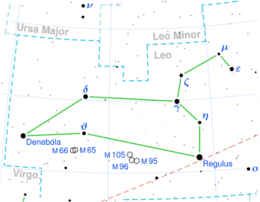Astronomy:Gamma Leonis
Gamma Leonis (γ Leonis, abbreviated Gamma Leo, γ Leo), also named Algieba /ælˈdʒiːbə/,[8][9] is a binary star system in the constellation of Leo. In 2009, a planetary companion around the primary was announced.
Nomenclature

γ Leonis (Latinised to Gamma Leonis) is the star's Bayer designation. The A and B components of the binary are often referred to as γ1 Leonis and γ2 Leonis, respectively.
It also bore the traditional name Algieba or Al Gieba, which originated from the Arabic الجبهة Al-Jabhah, meaning 'the forehead' (despite this meaning, the star actually appears in the mane of Leo). In 2016, the International Astronomical Union organized a Working Group on Star Names (WGSN)[10] to catalog and standardize proper names for stars. The WGSN's first bulletin of July 2016[11] included a table of the first two batches of names approved by the WGSN, which included Algieba for this star.
The star's traditional Latin name was Juba. It is known as 軒轅十二 (the Twelfth Star of Xuanyuan) in Chinese (Xuanyuan is the name of the Yellow Emperor).[citation needed]
Algieba, along with Zeta Leonis, Regulus, Mu Leonis, Epsilon Leonis and Eta Leonis, have collectively been called the Sickle, which is an asterism that marks the head of Leo.[12]
Stellar system
The bright binary system in Leo with orange-red and yellow or greenish-yellow components is visible through a modest telescope under good atmospheric conditions. To the naked eye, the Algieba system shines at mid-second magnitude, but a telescope easily splits the pair. The brighter component has an apparent magnitude of +2.28 and is of spectral class K1-IIIbCN-0.5. The giant K star has a surface temperature of 4,470 K, a luminosity 180 times that of the Sun, and a diameter 23 times that of the Sun. The companion star has an apparent magnitude of +3.51 and belongs to the spectral class G7IIICN-I. The giant G star has a temperature of 4,980 K and a luminosity of 50 times that of the Sun. With angular separation of just over 4″, the two stars are at least 170 astronomical unit|AU apart (four times the distance between the Sun and Pluto), and have an orbital period of over 500 years.[7] Because the orbital period is so long, only a fraction of the full path has been observed since discovery.
Variability
γ Leonis is a suspected variable star, with a visual magnitude range of 1.84 to 2.03. It is not known which of the two components is variable.[4] In 1959, the star was mistakenly published as an eclipsing binary due to a typographical error when referring to Y Leonis.[13]
Planetary system
On November 6, 2009, the discovery of a planetary companion around primary star γ1 Leonis (γ Leonis A) was announced.[3] The radial velocity measurements suggest two additional periodicities of 8.5 and 1,340 days. The former is likely due to stellar pulsation, whereas the latter could be indicative of the presence of an additional planetary companion with 2.14 Jupiter masses, moderate eccentricity (e=0.13) and located at 2.6 AU away from the giant star. Nevertheless, the nature of such a signal is still unclear and further investigations are needed to confirm or rule out an additional substellar companion.
| Companion (in order from star) |
Mass | Semimajor axis (AU) |
Orbital period (days) |
Eccentricity | Inclination | Radius |
|---|---|---|---|---|---|---|
| b | ≥8.78 MJ | 1.19 | 429 | 0.14 | — | — |
| c (unconfirmed) | ≥2.14 MJ | 2.6 | 1,340 | 0.13 | — | — |
References
- ↑ 1.0 1.1 1.2 1.3 1.4 van Leeuwen, F. (November 2007). "Validation of the new Hipparcos reduction". Astronomy and Astrophysics 474 (2): 653–664. doi:10.1051/0004-6361:20078357. Bibcode: 2007A&A...474..653V.
- ↑ Mason, Brian D.; Wycoff, Gary L.; Hartkopf, William I.; Douglass, Geoffrey G.; Worley, Charles E. (2001). "The 2001 US Naval Observatory Double Star CD-ROM. I. The Washington Double Star Catalog". The Astronomical Journal 122 (6): 3466–3471. doi:10.1086/323920. ISSN 0004-6256. Bibcode: 2001AJ....122.3466M.
- ↑ 3.0 3.1 3.2 3.3 3.4 3.5 Han, Inwoo; Lee, B. C.; Kim, K. M.; Mkrtichian, D. E.; Hatzes, A. P.; Valyavin, G. (2010). "Detection of a Planetary Companion around the giant star γ-1 Leonis". Astronomy and Astrophysics 509: A24. doi:10.1051/0004-6361/200912536. Bibcode: 2010A&A...509A..24H.
- ↑ 4.0 4.1 Samus, N. N. et al. (2009). "VizieR Online Data Catalog: General Catalogue of Variable Stars (Samus+ 2007-2013)". VizieR On-line Data Catalog: B/GCVS. Originally Published in: 2009yCat....102025S 1. Bibcode: 2009yCat....102025S.
- ↑ Famaey, B. et al. (January 2005), "Local kinematics of K and M giants from CORAVEL/Hipparcos/Tycho-2 data. Revisiting the concept of superclusters", Astronomy and Astrophysics 430: 165–186, doi:10.1051/0004-6361:20041272, Bibcode: 2005A&A...430..165F
- ↑ 6.0 6.1 6.2 6.3 6.4 6.5 6.6 McWilliam, Andrew (December 1990), "High-resolution spectroscopic survey of 671 GK giants. I - Stellar atmosphere parameters and abundances", Astrophysical Journal Supplement Series 74: 1075–1128, doi:10.1086/191527, Bibcode: 1990ApJS...74.1075M
- ↑ 7.0 7.1 Mason; Hartkopf, William I.; Wycoff, Gary L.; Holdenried, Ellis R. (2006). "Speckle Interferometry at the US Naval Observatory. XII". The Astronomical Journal 132 (5): 2219–2230. doi:10.1086/508231. Bibcode: 2006AJ....132.2219M. http://www.iop.org/EJ/article/1538-3881/132/5/2219/205407.html.
- ↑ Kunitzsch, Paul; Smart, Tim (2006). A Dictionary of Modern star Names: A Short Guide to 254 Star Names and Their Derivations (2nd rev. ed.). Cambridge, Massachusetts: Sky Pub. ISBN 978-1-931559-44-7.
- ↑ "IAU Catalog of Star Names". http://www.pas.rochester.edu/~emamajek/WGSN/IAU-CSN.txt.
- ↑ "IAU Working Group on Star Names (WGSN)". https://www.iau.org/science/scientific_bodies/working_groups/280/.
- ↑ "Bulletin of the IAU Working Group on Star Names, No. 1". http://www.pas.rochester.edu/~emamajek/WGSN/WGSN_bulletin1.pdf.
- ↑ Proctor, Mary (July 1896), "Evenings with the Stars", Popular Astronomy 4: 565, https://books.google.com/books?id=5gdLAAAAYAAJ&pg=PA565
- ↑ "Reports of Observatories". Astronomical Journal 64: 273. 1959. doi:10.1086/107936. Bibcode: 1959AJ.....64..273..
External links
- Algieba at Jim Kaler's Stars
- Astronomical Reference from Author David Darling
Coordinates: ![]() 10h 19m 58.3s, +19° 50′ 30″
10h 19m 58.3s, +19° 50′ 30″
 |


